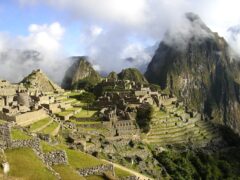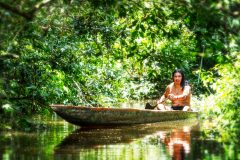
The Galápagos Islands are one of South America’s most enticing destinations, and after looking at the photos taken there by even the most amateur of photographers, it’s easy to see why. This environment is completely unique: a true Eden where wildlife has no fear of man.
Planning a Galápagos holiday can often be confusing, particularly with the Ecuadorian government now bringing in new regulations for all itineraries. I think the first thing to remember is that whichever route you choose, you will have an incredible experience simply because you are in the Galápagos. I have never seen wildlife from so close up – snorkelling with sea turtles and penguins, kayaking beside sea lions and seeing an orca whale just ten feet away are definitely experiences I’ll never forget.
WHICH BOAT TO CHOOSE
People frequently ask what type of boat I would suggest and I often used to recommend going on one of the smaller boats, as I did on my first visit. However, after recently returning from a trip onboard the 48-personEclipse, I would now personally favour a larger vessel.
Different types of boats will suit different people, and if you like the idea of a more intimate experience with just a handful of other passengers on board, a smaller boat is for you. Being on a smaller boat also feels closer to sailing than cruising, and you could even consider chartering one if you are travelling with a group of friends or family.
On the other hand, a larger vessel usually has the advantage of better, and larger, common areas and facilities: spacious lounges and sundecks, perhaps even a Jacuzzi – perfect to jump into after a snorkelling trip in the colder months! They may also have more naturalist guides on board (it is a legal requirement to be accompanied by a guide in the Galápagos) which means that the groups can be divided into groups of ability and interest. For example, if some people wanted to go kayaking, others snorkelling and others on a dinghy ride, this would all be possible on the same day.
I travelled on the Eclipse in October when the sea can sometimes be a bit choppier, and a larger boat offers much more stability than a smaller boat which is a bonus if you’re a bit prone to sea sickness. Catamarans are the most stable of all vessel options and are becoming increasingly popular.
The other option is to stay on land, which is possible on some of the larger islands including Isabela, San Cristóbal and Santa Cruz. The advantage of this is the flexibility to choose whichever excursions you fancy whenever you feel like doing them, as well as the fact that this makes the stay more relaxing compared to a cruise with its busy itineraries that will keep you on the go for most of the day. You could of course do both – start with a cruise, then wind down with a couple of days on land afterwards.
If you want to dive, there are two options: some boats offer the opportunity of a day’s diving organised by a separate local operator, while there are a small number of boats (such as the Galápagos Sky) with their own diving license. These boats offer diving-only itineraries, aimed at experienced divers only.
GETTING THERE
The Galápagos Islands are part of the territory of Ecuador. To get there you fly from either Quito (3.5 hours) or Guayaquil (2 hours – the cheaper option), and arrive either at Baltra or San Cristóbal islands.
HOW LONG TO STAY
One benefit of the coming regulation changes is that they make the duration of the cruises more flexible – you will now be able to go for anything from 3 to 14 nights. I would recommend against the 3-night option as two days of activities is simply not enough and you will feel you are being dragged away against your will when it’s time to leave! The islands and excursions are surprisingly different and varied so really the answer to the question of how long to stay is the longer, the better. However if time or budget are issues I would say that a 5-night cruise is a good compromise.
WHEN TO GO AND WEATHER
There is no wrong time to go to the Galápagos: at each time of year some of the fauna species will be breeding, nesting or in some other way particularly active. The climate is not extreme and even in the wetter months the rain usually only comes in afternoon showers, which can actually be refreshing after the heat of the day. Generally speaking, between December and May the weather is hot with warm, calm seas and more chance of showers. Between June and November, it is cooler with morning mist and choppier, colder seas.
CRUISE ITINERARIES
With the new regulations being brought in for all 2012 itineraries, choosing the right itinerary is more important than ever. Each boat has a new itinerary that takes in a selection of islands that are split into either eastern/western or northern/southern islands. As I said before, whichever itinerary you choose I can guarantee you will have no regrets; however, if you are particularly interested in seeing a specific bird or animal it’s worth looking into the itineraries in more detail. For example, if you want to see the waved albatross make sure you have Española Island in your itinerary and visit between March and December, and if you want to see the flightless cormorant make sure you have Fernandina Island on your itinerary. The Galápagos penguin is found on Fernandina, Isabela and Bartlomé. On the other hand, if you want to see sea lions, blue-footed boobies, finches, marine iguanas or sea turtles the options are much broader as they are found in many places over the isles. Under the sea, hammerhead sharks and manta rays are also common in most areas.
Finally, although the Galápagos can feel like a once in a lifetime destination, it doesn’t have to be! Returning to the islands for a second time can be just as good, if not better, than the first time in my opinion. The different seasons offer a different view of the islands and the wildlife. In January, when I first went, the islands were green and lush and the adult marine iguanas were a bright green and red in order to attract females (the mating season was beginning). In October, when I went for the second time, the islands appeared wild and desolate without all the lush vegetation and it made you appreciate just how incredible it is that wildlife is able to survive and thrive on the volcanic islands.
TOP TIPS
- Take smaller denominations of dollars to pay the entrance fee (paid on arrival).
- Check if wetsuits – useful in the cooler months – are provided on your boat.
- Most boats don’t have a formal dress code but require men to wear trousers for dinner.
- Remember that tipping is totally discretionary and the information about how much to give onboard the various boats is just a suggestion.
- Take binoculars if possible – although you will see the wildlife from so close that they are not absolutely necessary.
- Don’t forget to take a hat, high factor sun cream and lip salve. Lightweight walking boots are also recommended.
Tailor-made holidays
Flexible, custom-made holidays to Latin America created to match your exact requirements: our tailor-made itineraries are as unique as the clients for whom they are designed.
Design my tripPapagaio
Your edit for Latin American inspiration
Our exciting range of articles on Latin America explore everything from iconic destinations and lesser-known cultural gems to delicious traditional recipes. You’ll also find exclusive travel tips, first-hand client reviews and the chance to get your personal questions answered by our travel experts.
View Extraordinary Inspiration






































